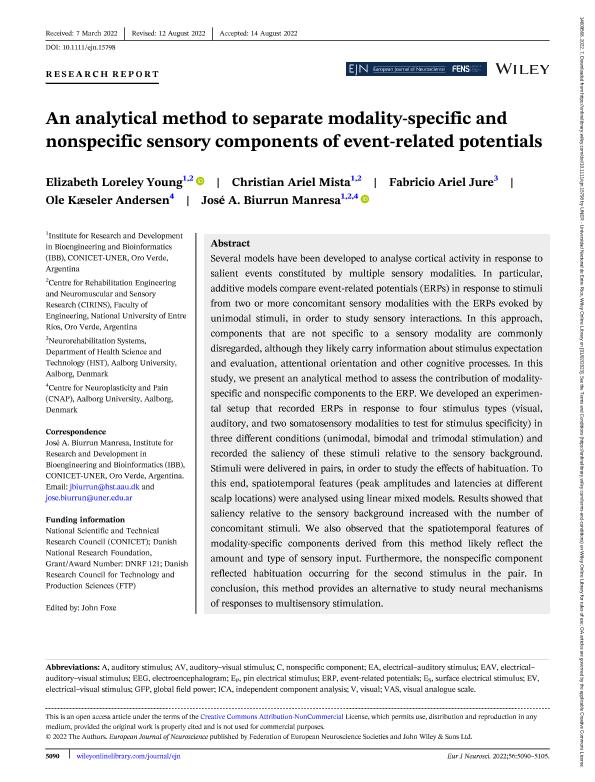Mostrar el registro sencillo del ítem
dc.contributor.author
Young, Elizabeth Loreley

dc.contributor.author
Mista, Christian Ariel

dc.contributor.author
Jure, Fabricio Ariel
dc.contributor.author
Andersen, Ole Kæseler
dc.contributor.author
Biurrun Manresa, José Alberto

dc.date.available
2023-09-22T16:52:42Z
dc.date.issued
2022-10
dc.identifier.citation
Young, Elizabeth Loreley; Mista, Christian Ariel; Jure, Fabricio Ariel; Andersen, Ole Kæseler; Biurrun Manresa, José Alberto; An analytical method to separate modality-specific and nonspecific sensory components of event-related potentials; Wiley Blackwell Publishing, Inc; European Journal of Neuroscience; 56; 7; 10-2022; 5090-5105
dc.identifier.issn
0953-816X
dc.identifier.uri
http://hdl.handle.net/11336/212750
dc.description.abstract
Several models have been developed to analyse cortical activity in response to salient events constituted by multiple sensory modalities. In particular, additive models compare event-related potentials (ERPs) in response to stimuli from two or more concomitant sensory modalities with the ERPs evoked by unimodal stimuli, in order to study sensory interactions. In this approach, components that are not specific to a sensory modality are commonly disregarded, although they likely carry information about stimulus expectation and evaluation, attentional orientation and other cognitive processes. In this study, we present an analytical method to assess the contribution of modality-specific and nonspecific components to the ERP. We developed an experimental setup that recorded ERPs in response to four stimulus types (visual, auditory, and two somatosensory modalities to test for stimulus specificity) in three different conditions (unimodal, bimodal and trimodal stimulation) and recorded the saliency of these stimuli relative to the sensory background. Stimuli were delivered in pairs, in order to study the effects of habituation. To this end, spatiotemporal features (peak amplitudes and latencies at different scalp locations) were analysed using linear mixed models. Results showed that saliency relative to the sensory background increased with the number of concomitant stimuli. We also observed that the spatiotemporal features of modality-specific components derived from this method likely reflect the amount and type of sensory input. Furthermore, the nonspecific component reflected habituation occurring for the second stimulus in the pair. In conclusion, this method provides an alternative to study neural mechanisms of responses to multisensory stimulation.
dc.format
application/pdf
dc.language.iso
eng
dc.publisher
Wiley Blackwell Publishing, Inc

dc.rights
info:eu-repo/semantics/openAccess
dc.rights.uri
https://creativecommons.org/licenses/by-nc/2.5/ar/
dc.subject
ELECTROENCEPHALOGRAM
dc.subject
HABITUATION
dc.subject
MULTISENSORY STIMULATION
dc.subject
SALIENCY
dc.subject.classification
Otras Ciencias Médicas

dc.subject.classification
Otras Ciencias Médicas

dc.subject.classification
CIENCIAS MÉDICAS Y DE LA SALUD

dc.title
An analytical method to separate modality-specific and nonspecific sensory components of event-related potentials
dc.type
info:eu-repo/semantics/article
dc.type
info:ar-repo/semantics/artículo
dc.type
info:eu-repo/semantics/publishedVersion
dc.date.updated
2023-07-07T20:46:43Z
dc.journal.volume
56
dc.journal.number
7
dc.journal.pagination
5090-5105
dc.journal.pais
Reino Unido

dc.journal.ciudad
Londres
dc.description.fil
Fil: Young, Elizabeth Loreley. Universidad Nacional de Entre Ríos. Instituto de Investigación y Desarrollo en Bioingeniería y Bioinformática - Consejo Nacional de Investigaciones Científicas y Técnicas. Centro Científico Tecnológico Conicet - Santa Fe. Instituto de Investigación y Desarrollo en Bioingeniería y Bioinformática; Argentina. Universidad Nacional de Entre Ríos. Facultad de Ingeniería. Departamento de Bioingeniería. Laboratorio de Ingeniería en Rehabilitación e Investigaciones Neuromusculares y Sensoriales; Argentina
dc.description.fil
Fil: Mista, Christian Ariel. Universidad Nacional de Entre Ríos. Instituto de Investigación y Desarrollo en Bioingeniería y Bioinformática - Consejo Nacional de Investigaciones Científicas y Técnicas. Centro Científico Tecnológico Conicet - Santa Fe. Instituto de Investigación y Desarrollo en Bioingeniería y Bioinformática; Argentina. Universidad Nacional de Entre Ríos. Facultad de Ingeniería. Departamento de Bioingeniería. Laboratorio de Ingeniería en Rehabilitación e Investigaciones Neuromusculares y Sensoriales; Argentina
dc.description.fil
Fil: Jure, Fabricio Ariel. Aalborg University; Dinamarca
dc.description.fil
Fil: Andersen, Ole Kæseler. Aalborg University; Dinamarca
dc.description.fil
Fil: Biurrun Manresa, José Alberto. Universidad Nacional de Entre Ríos. Instituto de Investigación y Desarrollo en Bioingeniería y Bioinformática - Consejo Nacional de Investigaciones Científicas y Técnicas. Centro Científico Tecnológico Conicet - Santa Fe. Instituto de Investigación y Desarrollo en Bioingeniería y Bioinformática; Argentina. Universidad Nacional de Entre Ríos. Facultad de Ingeniería. Departamento de Bioingeniería. Laboratorio de Ingeniería en Rehabilitación e Investigaciones Neuromusculares y Sensoriales; Argentina. Aalborg University; Dinamarca
dc.journal.title
European Journal of Neuroscience

dc.relation.alternativeid
info:eu-repo/semantics/altIdentifier/url/https://onlinelibrary.wiley.com/doi/10.1111/ejn.15798
dc.relation.alternativeid
info:eu-repo/semantics/altIdentifier/doi/http://dx.doi.org/10.1111/ejn.15798
Archivos asociados
